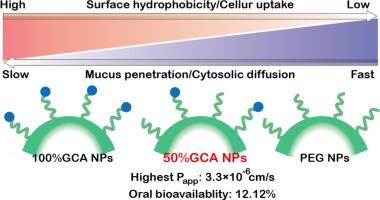Balancing oral sequential absorption barriers of semaglutide-loaded nanoparticles by optimization of surface glycocholic acid density
IF 11.5
1区 医学
Q1 CHEMISTRY, MULTIDISCIPLINARY
引用次数: 0
Abstract
Nanoparticles (NPs) modified with glycocholic acid (GCA) at surfaces are considered promising tools to overcome oral drug delivery barriers. However, question on the influence of surface GCA density over delivery efficiency arises due to ligand-induced changes in surface properties of NPs. To answer this question, we engineered GCA-modified nanoparticles (GCA NPs) with different surface densities, and their surface hydrophobicity, mucus penetration, cellular uptake, apparent permeability coefficient (Papp), intracellular trafficking behavior and oral bioavailability were compared. The results turned out that GCA NPs were found with increased surface hydrophobicity, which limited their transport across mucus layer. Nanoparticles with 50 % surface GCA density (50 % GCA NPs) demonstrated optimal performance. Compared to 100 %GCA NPs, 50 %GCA NPs exhibited an 83.28 % improvement in mucosal penetration capability, while a 250.67 % increase in cellular uptake was noticed when comparing with PEG NPs. Overall, the 50 % GCA NPs significantly enhanced trans-epithelial transport across Caco-2/E-12 co-cultured monolayers, achieving a Papp value of 3.30 × 10−6 cm/s, while the Papp values of 100 %GCA NPs and PEG NPs were 2.23 × 10−6 cm/s and 1.73 × 10−6 cm/s. In vivo studies confirmed their therapeutic potential: oral administration of semaglutide (SMG)-loaded 50 % GCA NPs increased systemic SMG bioavailability to 12.12 %, achieving sustained glycemic control in type 2 diabetic rats. The optimized formulation exhibited favorable safety profiles and prolonged pharmacological effects. This study establishes a critical equilibrium between enhanced mucosal penetration and ligand-receptor interaction, while mitigating intracellular retention issues associated with high-density GCA-functionalized nanoparticles. These findings indicate that attentions should be paid in ligand-associated surface property alterations, which could exert unexpected influence on the performance of NPs constructed for oral peptide drug delivery.

通过优化表面糖胆酸密度来平衡负载semaglutide纳米颗粒的口服顺序吸收屏障
在表面修饰了糖胆酸(GCA)的纳米颗粒(NPs)被认为是克服口服药物递送障碍的有前途的工具。然而,由于配体诱导NPs表面性质的变化,表面GCA密度对递送效率的影响问题出现了。为了回答这个问题,我们设计了具有不同表面密度的GCA修饰纳米粒子(GCA NPs),并比较了它们的表面疏水性、粘液渗透性、细胞摄取、表观渗透系数(Papp)、细胞内运输行为和口服生物利用度。结果表明,GCA NPs的表面疏水性增加,这限制了它们在黏液层上的运输。表面GCA密度为50% % (GCA NPs为50% %)的纳米颗粒表现出最佳性能。与100 %GCA NPs相比,50 %GCA NPs的粘膜穿透能力提高了83.28 %,而与PEG NPs相比,细胞摄取增加了250.67 %。总的来说,50 % GCA NPs显著提高跨Caco-2 trans-epithelial运输/ E-12单层培养,实现Papp值3.30 × 10−6 cm / s,而Papp值100 % GCA NPs和挂钩NPs 2.23 × 10−6 cm / s和1.73 × 10−6 cm / s。体内研究证实了它们的治疗潜力:口服含有50% % GCA NPs的semaglutide (SMG)将SMG的全身生物利用度提高到12.12 %,实现2型糖尿病大鼠的持续血糖控制。优化后的配方具有良好的安全性和长效的药理作用。本研究在增强粘膜渗透和配体-受体相互作用之间建立了一个临界平衡,同时减轻了高密度gca功能化纳米颗粒相关的细胞内潴留问题。这些发现表明,配体相关的表面性质改变可能会对用于口服肽药物递送的NPs的性能产生意想不到的影响,因此应该引起人们的注意。
本文章由计算机程序翻译,如有差异,请以英文原文为准。
求助全文
约1分钟内获得全文
求助全文
来源期刊

Journal of Controlled Release
医学-化学综合
CiteScore
18.50
自引率
5.60%
发文量
700
审稿时长
39 days
期刊介绍:
The Journal of Controlled Release (JCR) proudly serves as the Official Journal of the Controlled Release Society and the Japan Society of Drug Delivery System.
Dedicated to the broad field of delivery science and technology, JCR publishes high-quality research articles covering drug delivery systems and all facets of formulations. This includes the physicochemical and biological properties of drugs, design and characterization of dosage forms, release mechanisms, in vivo testing, and formulation research and development across pharmaceutical, diagnostic, agricultural, environmental, cosmetic, and food industries.
Priority is given to manuscripts that contribute to the fundamental understanding of principles or demonstrate the advantages of novel technologies in terms of safety and efficacy over current clinical standards. JCR strives to be a leading platform for advancements in delivery science and technology.
 求助内容:
求助内容: 应助结果提醒方式:
应助结果提醒方式:


